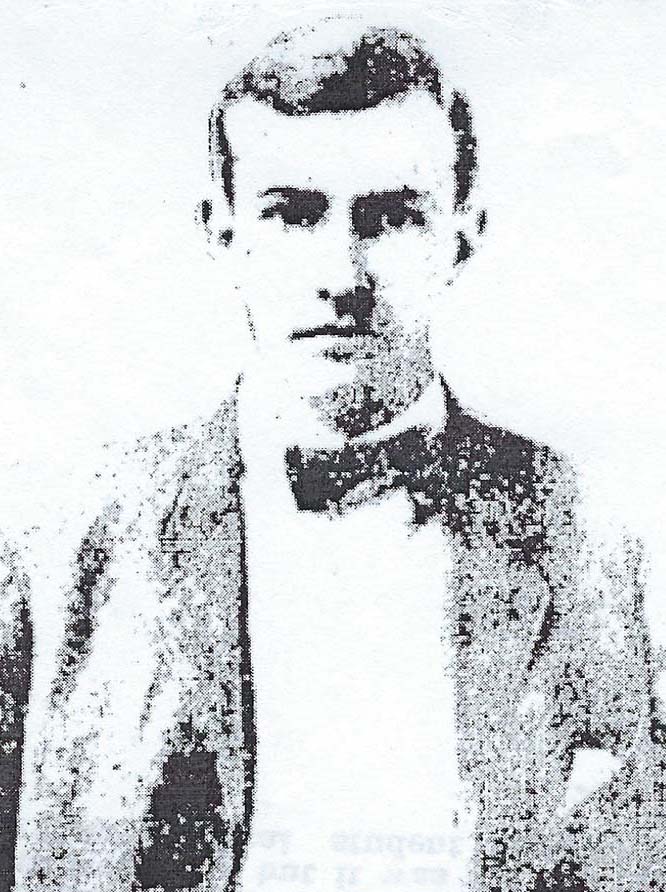Historical Reminiscing with Robert B. Hitchings
Copyright. All rights reserved.
An Unknown Hero in
St. John’s Episcopal Churchyard, Hampton, Virginia

H. Guy Brown
What is a hero? Heroes are in every cemetery, but one has to look for them. A hero is usually a civilian who knowingly risks death or a serious physical injury in trying to save the life of an ordinary citizen. Heroes come in all sizes and sexes. And, as time goes by, these heroes are forgotten like so many individuals that have passed away. Their stories should be told and retold for future generations. And each story is unique!
A few weeks ago, as an archivist at the Wallace History Room, Chesapeake, Virginia, I was archiving old turn-of-the-century Virginian-Pilot newspapers that a dear patron presented to us. One of those newspapers had a fantastic article about a Norfolk native who attempted to save the life of an African-American youth who had been overcome by poisonous fumes in a sewage manhole in Charleston, South Carolina. The date of the newspaper was January 26, 1913. Without hesitation, H. Guy Brown (1884-1911) jumped into the gas-filled sewer line to save his friend and work companion, Joseph Freer. Like all accidents this incident happened so fast. Young Brown noticed that something was awry in the bottom of the chamber. He saw young Joe Freer crumpled up in a fetal position. Guy Brown sounded the alarm and quickly climbed down into the dark pit to save his co-worker. Within seconds Brown lifted Freer over his shoulder, but the poison gas began to take its effect on Guy Brown. He too succumbed to this gas. A young medical student named Blakeley was passing by when he took in this situation. He too quickly climbed down the manhole and wrapped a rope around both men to pull them up to safety. Both were taken to Roper Hospital where every effort was taken to save their lives but both men had expired. Young Brown was only 28 years old when he met his death.
A few weeks before this accident young Guy Brown was working inside the Tennessee contractors Guild & Company two-story office building when he noticed through a large picture window a runaway horse drawing a carriage going at a fast pace. Young Brown rushed down a flight of stairs, ran and was able to catch the bridle of the horse. Although he was dragged down a few blocks, he brought the horse to a complete halt. He had saved the occupants in the carriage from injury. He became the hero of Charleston, South Carolina.
A group of friends and well-wishers contacted the Carnegie Hero Fund Commission, a Pittsburgh-based foundation which was started by Andrew Carnegie, the steel magnet. The Carnegie Medal in the United States and Canada is issued to people that risk their lives to save others. This Medal of Honor organization is still going on strong today. It’s sad that we do not hear much about this organization.
The Carnegie Hero Fund Commission was started on January 25, 1904, when a terrible mine explosion occurred near Hardwick, Pennsylvania. Hundreds of people were killed instantly. Out of this mine explosion came a few heroes of that day that inspired Carnegie to found this Medal of Honor for Heroes that risked their lives to save others. Carnegie called this medal Heroes of Civilization.
H. Guy Brown was a civil-engineering graduate of Lehigh University in Bethlehem, Pennsylvania. For several years before going to Charleston, he worked on several projects for the city of Norfolk, Virginia, like building bridges, especially the great steel pier of the Virginia-Railroad. He was very successful in installing water and sewage lines in the 7th & 10th Wards of Norfolk, Virginia. He was well respected by all who knew him, and as a young engineer of unusual ability was expected to make a name for himself in his line of work.
In January 1913, two years after the death of H. Guy Brown, his mother, Mrs. J. W. Brown of Hampton, Virginia, received the silver Carnegie medal in recognition of the bravery (heroism) of her son. The medal read, “Awarded to H. Guy Brown, who died of suffocation in Charleston, South Carolina, trying to save the life of Joseph Freer on April 18, 1911.”
Today no one remembers this heroic young man, H. Guy Brown, who tried to rescue his co-worker, an African-American named Joe Freer. H. Guy Brown rests next to his older brother, Dr. John Williams Brown (1874-1933), in old St. John’s Episcopal churchyard in Hampton, Virginia.
“Greater love has no man than this: that he lay down his life for his friends.”
John 15:13Robert B. Hitchings is a seventh generation Norfolk resident, graduating with an Associate's Degree in Biology from Old Dominion University and BA in history from Virginia Wesleyan University. During his studies, he was awarded a scholarship from Emmanuel College, Cambridge, England, and he was an exchange student at Brooks-Westminster College, Oxford, England. From 1999-2014 he worked as head of the Sargeant Memorial History Room at Norfolk Public Library, and since then has headed the Wallace History Room at Chesapeake Public Library. He is also the President of the Norfolk County Historical Society, and for six years was a columnist for The Virginian-Pilot. Robert may be reached at nchs.wallaceroom@gmail.com